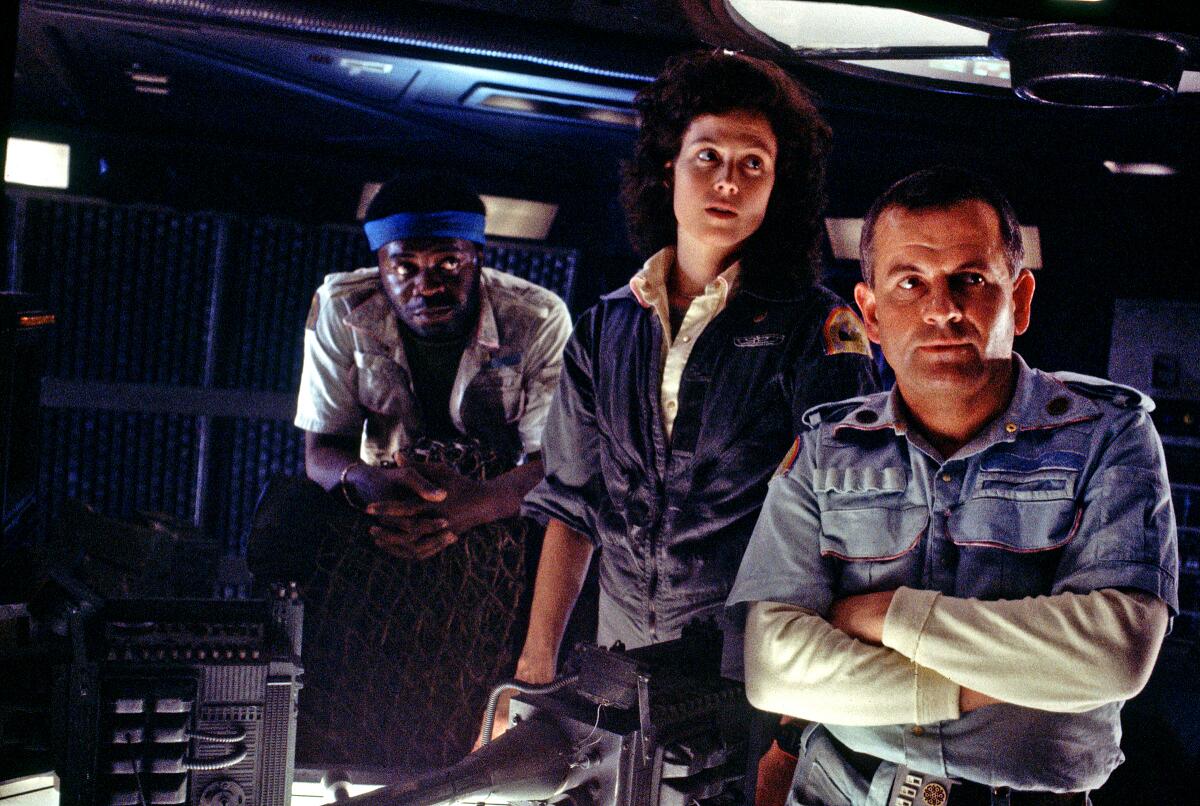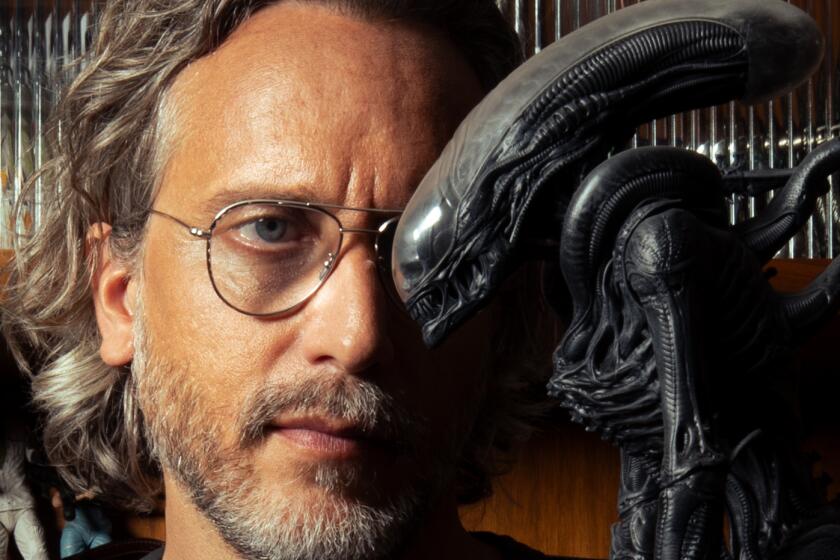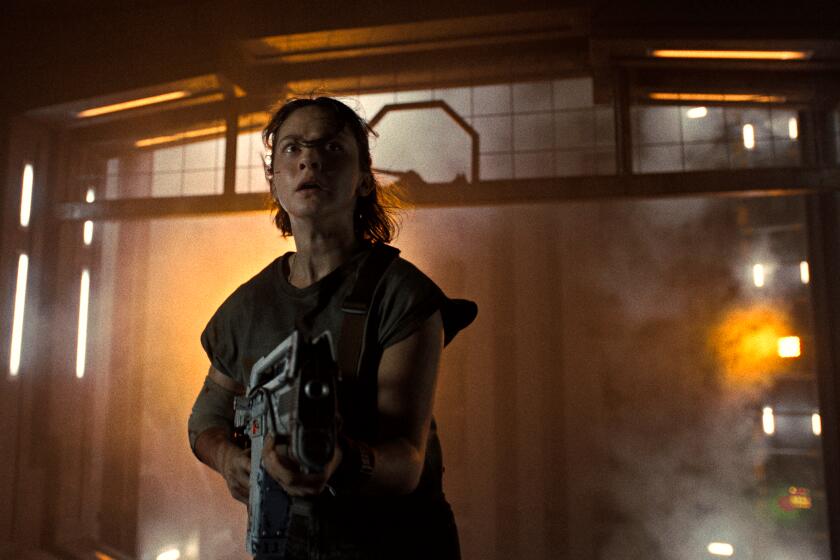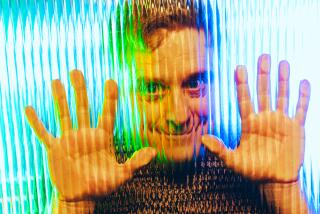The makers of ‘Alien: Romulus’ defend their AI-resurrected Ian Holm: ‘We did it all with a lot of respect’

- Share via
(Spoiler alert: If you haven’t seen “Alien: Romulus” — or, for that matter, the original 1979 “Alien” — consider holding off on this one.)
A familiar face appears unexpectedly a third of the way into “Alien: Romulus,” the gruesome new interquel in the “Alien” franchise currently in theaters.
The inclusion of a new “synthetic” (a humanoid android) bearing the likeness of the late actor Ian Holm has already sparked impassioned online reactions. Social media users have questioned the ethics of the multiple-scene cameo, with some calling it “digital necromancy.” Holm, who acted in “Chariots of Fire,” “Brazil” and “The Sweet Hereafter,” died in 2020 at age 88.
For Ridley Scott’s original 1979 sci-fi-horror classic “Alien,” Holm played Ash, a secretly synthetic crew member with ulterior motives. And now his face and voice have been resurrected as a new character named Rook, also synthetic. While “Alien: Romulus” director Fede Alvarez admits to using AI to create the illusion, he hopes viewers will consider the film’s larger intent.
“We were not trying to do what can’t be done, which is to reproduce that person’s talent as an actor, because this is another character,” Alvarez, 46, tells The Times. “The only thing they have in common is the likeness.”
After rebooting ‘Evil Dead’ and following up with ‘Don’t Breathe,” the filmmaker returns with ‘Alien: Romulus,” which he approached as a Ridley Scott fan first.
Among many other callbacks to both “Alien” and James Cameron’s 1986 sequel “Aliens,” the appearance of a half-destroyed android torso interacting with passengers was always part of the new narrative — even before deciding what it would look like.
“We knew we were going to create an animatronic,” says Alvarez, using the term for an on-set lifelike robot, “and that later we were going to do CGI enhancements in the mouth and in the eyes depending on the shots. “Then the question arose, ‘What face does it have? Who is it?’”
Alvarez says his team considered the whole range of synthetics in “Alien” films over the years: Lance Henriksen appeared as Bishop in “Aliens” and then again in David Fincher’s 1992 “Aliens 3” — in the latter as a legless torso on a table like Rook — while Michael Fassbender played David 8 in Scott’s “Prometheus” and Walter One in “Alien: Covenant.”
“The only one who hadn’t reappeared and who we found fascinating was Ian Holm,” Alvarez says.
Alvarez reached out to Holm’s widow, Sophie de Stempel, to explain the idea and to ask for her thoughts. Then he discussed it with Scott, who had remained acquainted with Holm throughout his life. Both parties were enthusiastic about the proposition for “Romulus.”
“In the last 10 years after ‘The Hobbit,’ Ian Holm felt like Hollywood had turned its back on him and his widow felt he would have loved to be a part of this,” says Alvarez. “He loved this character in particular.”
Scott sees the presence of Rook as a way for Alvarez to “dip into some of the artifacts from the very first film,” he says.
“Ian Holm suddenly appearing as a company on-board robot — that’s bit of an old-fashioned word there — was a great idea,” says Scott, 86. “That’s how ideas work. Grand ideas evolve. The next step is ‘Blade Runner,’ where you get Roy Batty as an evolved replicant, a human who’s not human, but actually in essence, in old terminology, a robot.”
Back in the first “Alien,” Scott recalls, the shocking revelation that Holm’s character Ash was not human was pivotal to the story, since they had to be prudent with how much of the creature they showed. “We were running out of big, quick scares and glimpses of an alien, because in those days I didn’t have these digital effects,” he says.
Led by an empathetic Cailee Spaeny in action-hero mode, the new sequel owes more to Ridley Scott’s 1979 original than to other installments — for good and ill.
For the production of “Romulus,” Rook was designed as an animatronic in the image of Holm, with facial movements that were the work of off-camera human maneuvering.
“It was 80 to 90% done by the puppeteers depending on the shot,” says Alvarez, describing the subsequent CGI enhancements in postproduction as eye work (“so that the animatronic had a little more life”) and in the mouth to make the lip sync better.
He also had British actor Daniel Betts on set in Budapest to record the facial capture with the cast. During filming, the lines were read in real time using the animatronic. Betts’ voice was then transformed to sound more like Holm’s using generative AI and computer modeling.
“We’re not bringing someone back to life and saying, ‘Ian would have done it that way,’” says the director. “He would have obviously done it differently. We had an actor who was on the set, who worked on the dialogue, who worked with the actors. It’s not like we skipped hiring an actor.”
Alvarez doesn’t think it’s feasible for AI to replace actors in the near future. His choice to use those tools to create Rook, he says, was solely specific to this film and this franchise.
“It’s so much more expensive to do it the way we did it — it’s much cheaper to just hire an actor,” Alvarez explains in his defense. “Doing it this way requires a team of so many people and so many parts to get it done that it’s never going to be really convenient.”
Alvarez maintains that Rook is a character with a distinct personality from Ash, and that his motivation for using Holm’s likeness and voice was a genuine desire to honor his place in the franchise’s history.
“We did it all with a lot of respect and always with the authorization of his family, his children and his widow, who said, ‘We would love to see his likeness again,’” Alvarez says.
More to Read
Only good movies
Get the Indie Focus newsletter, Mark Olsen's weekly guide to the world of cinema.
You may occasionally receive promotional content from the Los Angeles Times.












